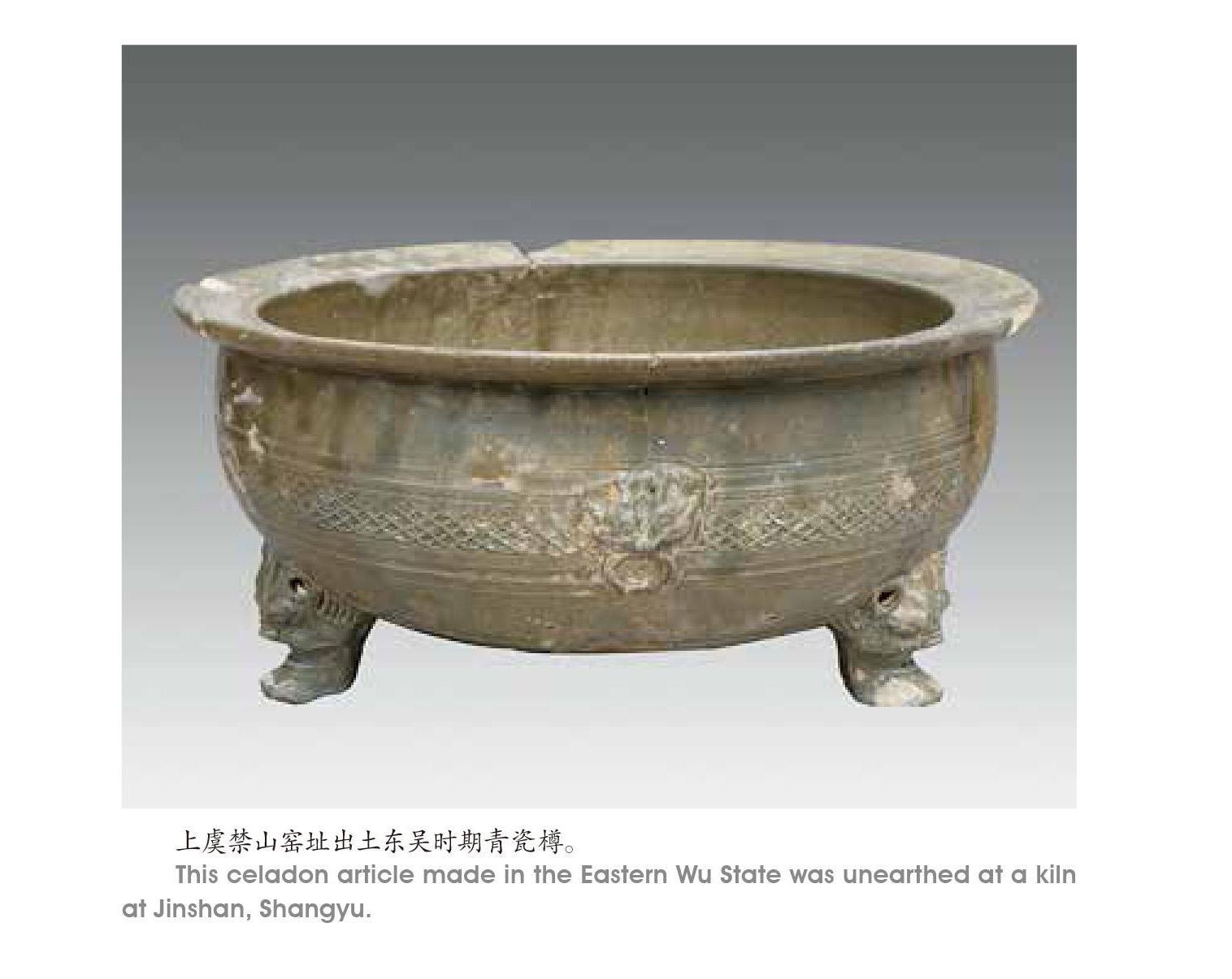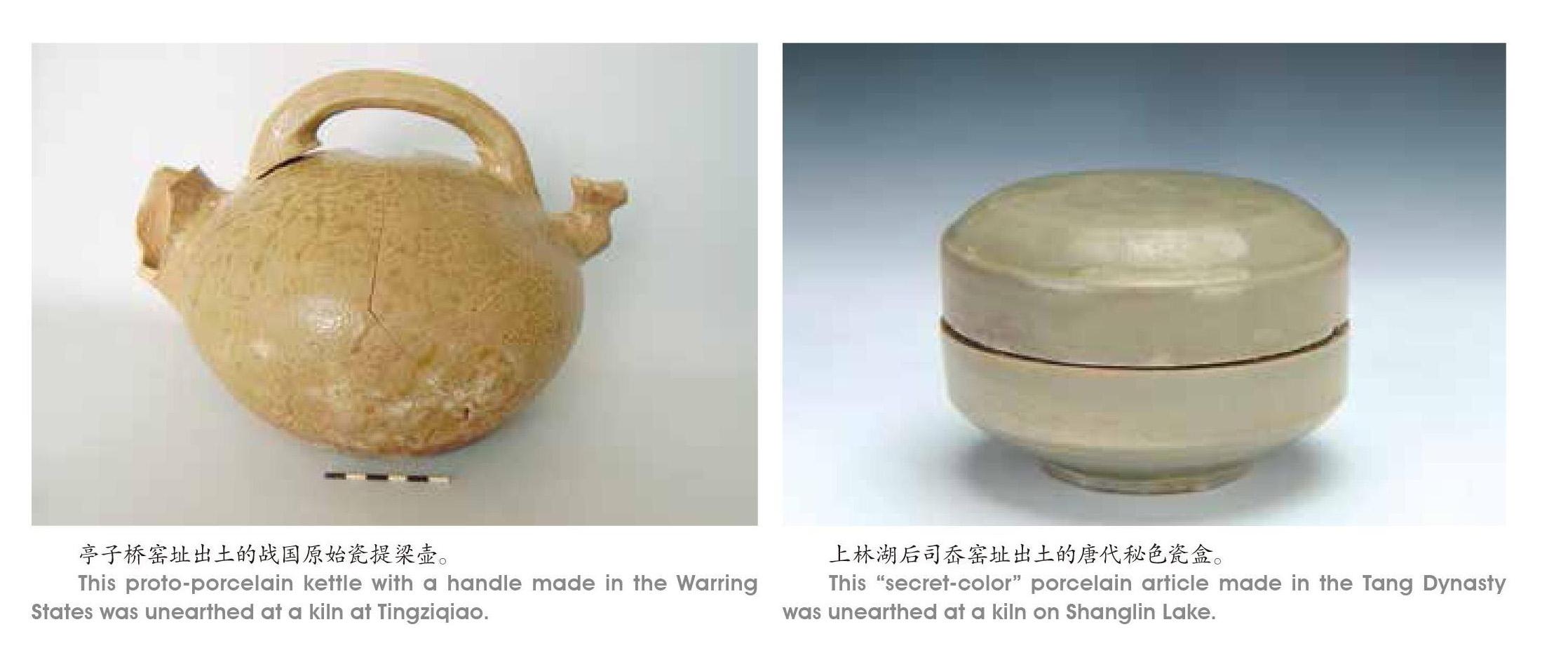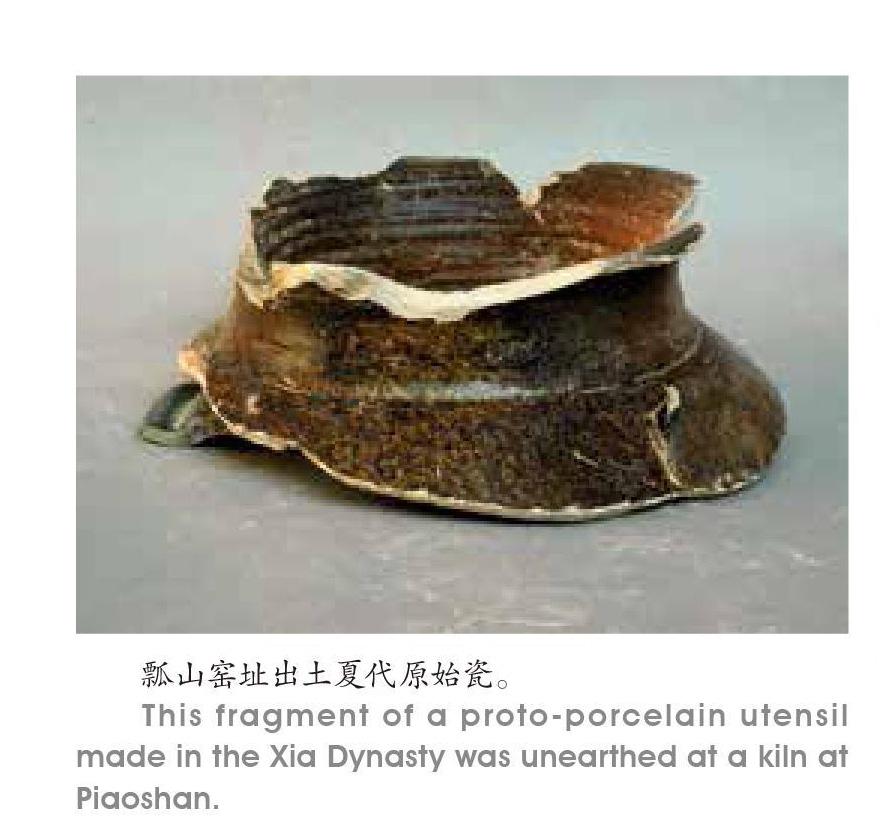浙江青瓷和它引領的風流
鄭建明



浙江青瓷在明代之前一直居于窯業中心的地位。無論是越窯還是龍泉窯,不僅技術高超,生產規模亦十分龐大,遠非國內其他任何一個窯場可以相比。
瓷器是中國古代最偉大的發明之一,而浙江又是瓷器的故鄉,是古代浙江人對世界文明的偉大貢獻。
一部陶瓷史,半部在浙江。
浙江的制瓷業從夏商時期開始,延及明清,其主流發展過程包括先秦時期的原始瓷、漢六朝時期的早期越窯、唐宋時期的越窯、宋元明時期的龍泉窯。此外杭州的南宋官窯、浙北的德清窯、浙中西地區的婺州窯、浙東南地區的甌窯亦各領風騷。同時,受江西、福建地區影響,在浙西、浙南一帶亦有相當數量的青白瓷、黑瓷、青花瓷等窯址的存在,如臨安地區以生產青白瓷為主兼燒黑瓷的天目窯等。這些窯口與窯場,構成了浙江古代完整的制瓷業畫面。
在紛繁復雜的窯業中,以先秦時期的原始瓷、漢六朝時期的早期越窯、唐宋時期的越窯、宋元明時期的龍泉窯與南宋官窯構成主體,前后相續,形成一浪高過一浪的發展進程,引領著中國制瓷業的發展。
因此,所謂的浙江青瓷,主要是指這四個發展進程中的五大窯口:他們以青瓷為絕對主流,產品面貌相對一致,燒造技術不斷精進,產品行銷全國乃至全世界,技術輻射整個東亞、東南亞以及西亞、北非地區,在中國制瓷史上占據主導地位。
浙江是瓷器的故鄉
瓷器的起源是一個漫長的過程,它先后經歷了先秦時期原始瓷的起源與發展以及漢六朝時期成熟青瓷的起源與發展兩個過程。
制瓷史上的兩個里程碑式技術躍進——原始瓷的起源與成熟青瓷的出現,均發生在浙江,浙江不僅在夏商時期發明了原始瓷,而且在東漢時期成功燒造出了成熟青瓷。同時,這一偉大的技術成果,造就了先秦與漢六朝時期浙江作為全國乃至全世界制瓷中心的地位。
支撐浙江作為世界瓷器起源地的重要證據,是大量古代瓷窯址資料,尤其是大量先秦原始瓷窯址及漢六朝時期的成熟青瓷窯址,數量龐大,時代上早于世界上任何一個地區,發展序列完整、制瓷技術高超,是探索世界瓷器起源、證明中國是瓷器起源地的最重要與最直接材料。
先秦時期浙江原始瓷窯址,主要分布在浙江北部以德清縣為中心的東苕溪流域。這一窯區具有以下特點:
首先,是出現時間早、持續時間長,是目前國內已知出現時間最早、持續時間最長的先秦時期窯區。其次,是窯址密集、生產規模大。第三,是產品種類豐富。第四,是產品質量高超。第五,是窯業技術先進。第六,是獨立窯區的出現。
因此,以德清為中心的東苕溪流域的商周時期窯區,無論是從生產時間、窯址規模,還是窯址產品種類、產品質量、燒造工藝等方面,在全國都是獨一無二的,是中國制瓷史上的第一個高峰,為漢代成熟青瓷的出現打下了堅實的技術基礎。
成熟青瓷的起源及其第一次興盛,主要在上虞的曹娥江流域完成。
上虞曹娥江流域成熟青瓷的起源過程十分清晰:在該區域內發現的數十處東漢時期窯址群中,大致可以劃分成以生產硬陶與原始瓷器為主的窯址、原始瓷與成熟青瓷合燒的窯址、以及純燒成熟青瓷的窯址等多個類型。這些不同類型的窯址中,原始瓷比例由高到低,成熟青瓷的比例則由低到高,代表了成熟青瓷起源的完整發展過程。最終以上虞小仙壇窯址為代表,完成了成熟青瓷的起源過程。
成熟青瓷起源后,在東漢晚期、三國、西晉時期迎來了制瓷業的大發展。其產品種類豐富多樣,裝飾華麗,包括燒成溫度、吸水率等在內的理化測試數據,甚至超過許多唐宋時期的產品。這些高質量的器物,目前僅發現于南京及其周邊地區的高等級墓葬中,是身份與地位的重要象征。同時由于龍窯技術的改進,使這一時期的產量有了巨大的提升,瓷器走進尋常百姓人家成為了可能。
因此上虞曹娥江流域漢六朝時期窯址群,代表著當時最高的制瓷技術水平和最大的生產規模,引領著中國成熟青瓷制瓷業的發展。
引領明代之前窯業發展
唐代之前的中國制瓷業,基本集中在浙江地區,浙江制瓷史幾乎等同于中國乃至世界的制瓷史。進入隋唐以后,由于北方白瓷的發明,從而在唐代中晚期形成南(方)青(瓷)北(方)白(瓷)的基本格局,但是以越窯為代表的唐宋時期浙江制瓷業,在技術上仍一直居于時代的巔峰。
越窯是我國古代燒制青瓷器的名窯,位于浙江省慈溪市的上林湖是其核心產區,興盛于唐代晚期至北宋早期,南宋早期仍舊為宮廷燒造瓷器,其產品種類豐富,造型優美,釉層滋潤如玉。部分器物形制巨大而復雜,質量高超,是我國唐宋時期生產宮庭用瓷的主要窯場。其創燒的秘色瓷代表了薄釉青瓷的最高水平,是制瓷技術上的巨大突破,同時亦成為唐以后歷代最高等級青瓷的代名詞。
宋元明時期的龍泉窯是我國文化內涵龐雜、生產地域廣闊、規模十分壯觀的青瓷窯業系統,也是中國歷代青瓷工藝技術發展的集大成者,在中國陶瓷史上占有極其重要的地位。它主要分布于浙江境內的甌江流域,其主體遺存和瓷業生產中心位于甌江上游的龍泉市,目前保存窯址近400處。其開創的粉青、梅子青厚釉青瓷,以失透如玉的效果,在古代瓷器中獨樹一幟,形成了自己獨特的風格,并由此進入了古代名窯的行列。而這一時期南宋官窯,是目前能確定的最早官窯遺址,代表了這一時期最高的制瓷水平。
無論是越窯還是龍泉窯,不僅技術高超,生產規模亦十分龐大,遠非國內其他任何一個窯場可以與之相比。因此浙江青瓷在明代之前一直居于窯業中心的地位。
浙江青瓷與“一帶一路”
地處東海之濱的浙江,山清水秀,人杰地靈,以出能工巧匠以及各種名優物產而名動天下。在對外輸出的物品中,瓷器占很大比例并被大量保存下來:不論是水下的沉船,還是各地的港口、城址、海防遺址,瓷器都是最為豐富的出土物,更不用說北起韓日、南及東南亞、西至東北非各個國家博物館所藏數量龐大的歷代浙江青瓷了。
浙江青瓷的輸出歷史相當悠久。北方出土的大部分先秦時期的原始瓷,就是從以浙江為中心的越地輸入的。從三國、西晉開始,是中國真正意義上的瓷器輸出時期,輸出地區主要是東北亞的朝鮮半島,產品均為越窯青瓷器;到了東晉南朝時期,不僅數量有所提高,而且窯口增加了德清窯等,產品類型也從青瓷增加到黑釉瓷器,由此形成了浙江青瓷對外輸出的第一個小高潮。
伴隨著越窯青瓷在晚唐至五代、北宋早期鼎盛時期的到來,浙江青瓷也迎來了對外輸出的第一個高峰,尤其是9~11世紀,除輸出到傳統的東北亞韓日等國家外,足跡廣及東南亞、南亞、西亞以及東北非諸港口與城市,并且占中國對外輸出瓷器的絕對主流。
龍泉窯作為我國最后形成的龐大青瓷窯場,對中國的制瓷業、中國文化及中外文化交流等具有重要的影響。宋元明時期,龍泉窯的制瓷技術呈放射狀向外傳播,除周邊的麗水、金華、衢州、溫州許多縣市均有生產外,還遠及福建、江西、兩廣甚至貴州一帶,形成龐大的龍泉窯系,在中國制瓷史上占有重要地位。除技術外,龍泉窯的產品影響范圍更大,不僅在國內有廣泛的分布,而且還大量地遠銷日本、韓國以及東南亞、南亞、西亞、東非諸國,是中外文化交流的重要載體。
浙江是瓷器的起源地,從夏商時期創燒了原始瓷器,經歷了商周至東漢初期的發展,在東漢中期前后創燒了成熟瓷器,并由此迎來了中國瓷器發展的又一波高峰,唐代之前的浙江制瓷史,幾乎等同于中國的制瓷史。唐宋元明時期的越窯與龍泉窯,一直引領著中國制瓷技術的發展。浙江青瓷除滿足國內市場的需求外,還大量輸出到海外市場:三國西晉時期從朝鮮半島開其風氣,到唐—北宋時期,越窯形成第一個高峰,南宋元明時期的龍泉窯則成了中國瓷器對外輸出的絕對主流,浙江青瓷由此構成了“一帶一路”中對外輸出的最大宗商品。
A Brief Overview of Celadon History
By Zheng Jianming
Zhejiang is a cradle of ceramics, one of the greatest inventions of ancient China. According to some scholars, half of the history of Chinese ceramics was written in Zhejiang. Ceramic manufacturing in the coastal province in eastern China started in the Xia (c. 2070-c. 1600BC) and the Shang (c. 1600-c. 1046), two earliest dynasties in China, and lasted up to the Qing (1644-1911).
Archaeological finds in Zhejiang indicate that kilns in the centuries prior to the Qin (221-207BC), early? kilns in the Han (202BC-220AD) and the Six Dynasties (222-589), the? kilns in the Tang (681-907) and the Song (960-1279), the Official Kilns of the Southern Song (1127-1279), and Longquan Kilns that operated from the Song, Yuan (1279-1368) and Ming (1368-1644), combined to be the mainstream celadon manufacturing not only in the province but also in China. These kilns in more than 2,000 years evolved and advanced step by step and their influences spread far and wide not only to the four corners of the country but also to the rest of the world. Celadon manufacturing techniques from Zhejiang were extensively copied in Asia and North Africa.
The genesis of ceramics took place slowly over a period of a long time. Temporally speaking, the proto-porcelain came into being and then became better and better in the centuries prior to the Qin. In the centuries that covered the Han and the Six Dynasties, celadon took shape and the technique became mature. The genesis of proto-porcelain and the appearance of celadon, which are two landmark technological transformations in the history of ceramics, took place in Zhejiang. The two epoch-making technologies marked Zhejiang as the center of the country and the world for porcelain making.
The kilns in Zhejiang that date back to the centuries before the Qin were largely located in Deqing, a rural county in the north of the province. The kilns in this region were the earliest ones in the period and operated for the longest time. Moreover, the kilns were tightly organized in the region and constituted a large-scale production and very good quality unseen anywhere in the country. The kilns, unique in China in terms of quantity, quality, design, technology, management, manifest the first complete chapter in the history of porcelain making of China. And they laid a solid foundation for the appearance of mature celadon in the Han Dynasty.
Celadon manufacturing appeared and flourished at kilns along the Caoe River in present-day Shangyu, which is now a district of Shaoxing in eastern Zhejiang. In this region, dozens of kiln sites have been unearthed. Some kilns were exclusively engaged in producing stoneware and proto-porcelain, some manufactured a mix of stoneware, proto-porcelain and celadon, and some were dedicated to celadon production. A close look at these kilns reveals that celadon production improved and gradually yielded top-quality products whereas stoneware and proto-porcelain production gradually phased out.
From the late period of the Eastern Han to the Three Kingdoms and Western Jin, celadon manufacturing boomed. The kilns turned out a great variety of finely designed products. Modern tests indicate that the celadon products made during these centuries were even better than those made in the Tang and the Song in terms of firing temperatures and water absorption. Such top-quality celadon objects we see today are from tombs of the high-class people around Nanjing, the capital city of many dynasties during this period. It can be reasoned that the kilns along the Caoe River in eastern Zhejiang during the Six Dynasties period featured the best celadon-making technology and largest industrial scope in China.
The national porcelain making industry before the Tang Dynasty (618-907) was essentially centered in Zhejiang. In other words, the history of porcelain making in Zhejiang during that time explains the porcelain making in both China and the world. In the dynasties of the Sui (581-618) and the Tang, white porcelain appeared in the north whereas the celadon production remained strong in the south. From centuries of the Tang to the Song, the kilns in Zhejiang were technologically the most advanced.
So called? kilns were represented by the kilns around Shanglin Lake in present-day Cixi, a city in eastern Zhejiang. The core of the porcelain making industry flourished in the lake zone from the late period of the Tang to the early part of the Northern Song. In the early period of the Southern Song, kilns around the lake still manufactured fine ceramics for the royal court. The kilns were a major supplier of porcelain pieces for the use of the court for the Tang and the Song dynasties. The “secret-color porcelain” represented the best of the thin glaze celadon. The secret-color porcelain was a breakthrough in porcelain making and stands for the top-class celadon from the Tang on.
The kilns in Longquan in southern Zhejiang combined to be the best celadon production system. Longquan kilns were largely scattered along the Oujiang River in the south of Zhejiang Province. The core region of this phenomenal celadon production system was in Longquan, now a city on the upper stream of the Oujiang River. There are nearly 400 kiln sites in Longquan. The thick-glaze celadon in the color of pale green and plum green invented in Longquan is the distinct feature of the celadons produced in Longquan.
In terms of technology and production scale, Zhejiang was the leader of Chinas porcelain manufacturing industry before the Ming Dynasty.
Export to Overseas Countries
Zhejiang began exporting porcelain products to the other parts of China in the centuries prior to the Qin. Most proto-porcelain pieces unearthed in archaeological sites in the north of China came from the kilns of Zhejiang. During the Six Dynasties, all the porcelain pieces China exported to Korean Peninsula were from the Yue kilns of Zhejiang. During the Eastern Jin and the Southern Dynasties, kilns at Deqing contributed a share of exportation, adding black-glazed porcelains to the celadon export. This was the first high peak of celadon export of Zhejiang.
Celadon export from Zhejiang first peaked from the 9th century to the 11th century. The celadon goods were exported to Korean and Japan as well as southeast, south and west of Asia, and north and east of Africa, as testified by archaeological finds at the port cities in these parts of the world. Celadon from Zhejiang accounted a major part of Chinas international porcelain trade during that time.
As China provided the international market with more and more celadon, celadon production no longer stayed in Longquan. There were many celadon kilns operating in neighboring regions such as Lishui, Jinhua, Quzhou and Wenzhou in the province. There were celadon kilns operating in Fujian, Jiangxi, Guangdong, Guangxi and even Guizhou. All these celadon kilns formed an extensive Longquan celadon manufacturing system, unseen in history.

